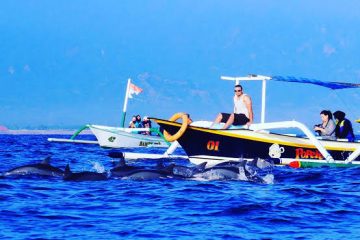{:en}Tanah Lot means “Land [in the] Sea” in the Balinese language. Located in Tabanan, about 20 kilometres (12 mi) from Denpasar, the temple sits on a large offshore rock which has been shaped continuously over the years by the ocean tide.Tanah Lot is claimed to be the work of the 16th-century Dang Hyang Nirartha. During his  travels along the south coast he saw the rock-island’s beautiful setting and rested there. Some fishermen saw him, and bought him gifts. Nirartha then spent the night on the little island. Later he spoke to the fishermen and told them to build a shrine on the rock, for he felt it to be a holy place to worship the Balinese sea gods. The main deity of the temple is Dewa Baruna or Bhatara Segara, who is the sea god or sea power and these days, Nirartha is also worshiped here.
travels along the south coast he saw the rock-island’s beautiful setting and rested there. Some fishermen saw him, and bought him gifts. Nirartha then spent the night on the little island. Later he spoke to the fishermen and told them to build a shrine on the rock, for he felt it to be a holy place to worship the Balinese sea gods. The main deity of the temple is Dewa Baruna or Bhatara Segara, who is the sea god or sea power and these days, Nirartha is also worshiped here.
The Tanah Lot temple was built and has been a part of Balinese mythology for centuries. The temple is one of seven sea temples around the Balinese coast. Each of the sea temples was established within eyesight of the next to form a chain along the south-western coast. In addition to Balinese mythology, the temple was significantly influenced by Hinduism.
At the base of the rocky island, venomous sea snakes are believed to guard the temple from evil spirits and intruders. The temple is purportedly protected by a giant snake, which was created from Nirartha’s selendang (a type of sash) when he established the island.
Restoration
In 1980, the temple’s rock face was starting to crumble and the area around and inside the temple started to become dangerous.[5] The Japanese government then provided a loan to the Indonesian government of Rp 800 billion (approximately US$130 million to conserve the historic temple and other significant locations around Bali. As a result, over one third of Tanah Lot’s “rock” is actually cleverly disguised artificial rock created during the Japanese-funded and supervised renovation and stabilization program.
Tourism
Tanah Lot Kuta
Sacred water at Tanah Lot temple
The area leading to Tanah Lot is highly commercialized and people are required to pay to enter the area (30,000 rupiah per person for domestic visitors; 60,000 rupiah per person for foreign visitors). To reach the temple, visitors must walk through a set of Balinese market-format souvenir shops which cover each side of the path down to the sea. On the mainland clifftops, restaurants have also been provided for tourists.
Source: Wikipedia
Location:
{:}{:id}Tanah Lot berarti “Tanah [di Laut]” dalam bahasa Bali. Terletak di Tabanan, sekitar 20 kilometer (12 mil) dari Denpasar, kuil ini terletak di sebuah batu lepas pantai besar yang telah dibentuk secara terus menerus selama bertahun-tahun oleh gelombang laut.
 Tanah Lot diklaim sebagai karya abad ke-16 Dang Hyang Nirartha. Selama perjalanannya di sepanjang pantai selatan, ia melihat pemandangan indah pulau batu itu dan beristirahat di sana. Beberapa nelayan melihatnya, dan membelikannya hadiah. Nirartha kemudian menghabiskan malam di pulau kecil itu. Kemudian dia berbicara kepada nelayan dan mengatakan kepada mereka untuk membangun sebuah kuil di atas batu, karena dia merasa itu menjadi tempat suci untuk menyembah dewa laut Bali. Dewa utama dari kuil adalah Dewa Baruna atau Bhatara Segara, yang merupakan dewa laut atau kekuatan laut dan hari-hari ini, Nirartha juga disembah di sini.
Tanah Lot diklaim sebagai karya abad ke-16 Dang Hyang Nirartha. Selama perjalanannya di sepanjang pantai selatan, ia melihat pemandangan indah pulau batu itu dan beristirahat di sana. Beberapa nelayan melihatnya, dan membelikannya hadiah. Nirartha kemudian menghabiskan malam di pulau kecil itu. Kemudian dia berbicara kepada nelayan dan mengatakan kepada mereka untuk membangun sebuah kuil di atas batu, karena dia merasa itu menjadi tempat suci untuk menyembah dewa laut Bali. Dewa utama dari kuil adalah Dewa Baruna atau Bhatara Segara, yang merupakan dewa laut atau kekuatan laut dan hari-hari ini, Nirartha juga disembah di sini.
Pura Tanah Lot dibangun dan telah menjadi bagian dari mitologi Bali selama berabad-abad. Candi ini adalah salah satu dari tujuh candi laut di sekitar pantai Bali. Masing-masing kuil laut didirikan dalam penglihatan berikutnya untuk membentuk rantai di sepanjang pantai barat daya. Selain mitologi Bali, candi secara signifikan dipengaruhi oleh agama Hindu.
Di dasar pulau berbatu, ular laut berbisa dipercaya untuk menjaga kuil dari roh jahat dan penyusup. Kuil ini konon dilindungi oleh ular raksasa, yang diciptakan dari selendang Nirartha (sejenis selempang) ketika ia mendirikan pulau itu.
Restorasi
Pada tahun 1980, wajah batu candi mulai runtuh dan daerah di sekitar dan di dalam kuil mulai menjadi berbahaya. [5] Pemerintah Jepang kemudian memberikan pinjaman kepada pemerintah Indonesia sebesar Rp 800 miliar (sekitar US $ 130 juta untuk melestarikan kuil bersejarah dan lokasi penting lainnya di sekitar Bali. Akibatnya, lebih dari sepertiga “rock” Tanah Lot sebenarnya adalah buatan yang disamarkan secara cerdik batu karang yang dibuat selama program renovasi dan stabilisasi yang dibiayai dan dibiayai Jepang.
Air suci di Pura Tanah Lot
Daerah yang mengarah ke Tanah Lot sangat dikomersialkan dan orang-orang diharuskan membayar untuk memasuki daerah tersebut (30.000 rupiah per orang untuk pengunjung domestik; 60.000 rupiah per orang untuk pengunjung asing). Untuk mencapai kuil, pengunjung harus berjalan melewati satu set toko-toko suvenir pasar-format Bali yang menutupi setiap sisi jalan ke laut. Di atas gundukan daratan, restoran juga disediakan untuk wisatawan.
Source: Wikipedia
Location:
{:}


